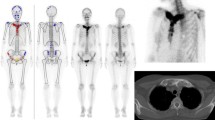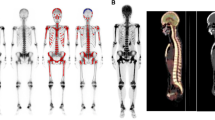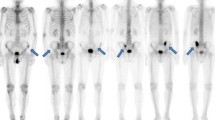Abstract
Objective
The aim of this study was to investigate the diagnostic ability of a completely automated computer-assisted diagnosis (CAD) system to detect metastases in bone scans by two patterns: one was per region, and the other was per patient.
Materials and methods
This study included 406 patients with suspected metastatic bone tumors who underwent whole-body bone scans that were analyzed by the automated CAD system. The patients were divided into four groups: a group with prostatic cancer (N = 71), breast cancer (N = 109), males with other cancers (N = 153), and females with other cancers (N = 73). We investigated the bone scan index and artificial neural network (ANN), which are parameters that can be used to classify bone scans to determine whether there are metastases. The sensitivities, specificities, positive predictive value (PPV), negative predictive value (NPV), and accuracies for the four groups were compared. Receiver operating characteristic (ROC) analyses of region-based ANN were performed to compare the diagnostic performance of the automated CAD system.
Results
There were no significant differences in the sensitivity, specificity, or NPV between the four groups. The PPVs of the group with prostatic cancer (51.0 %) were significantly higher than those of the other groups (P < 0.01). The accuracy of the group with prostatic cancer (81.5 %) was significantly higher than that of the group with breast cancer (68.6 %) and the females with other cancers (65.9 %) (P < 0.01). For the evaluation of the ROC analysis of region-based ANN, the highest Az values for the groups with prostatic cancer, breast cancer, males with other cancers, and females with other cancers were 0.82 (ANN = 0.4, 0.5, 0.6, 0.7, and 0.8), 0.83 (ANN = 0.7), 0.81 (ANN = 0.5), and 0.81 (ANN = 0.6), respectively.
Conclusion
The special CAD system “BONENAVI” trained with a Japanese database appears to have significant potential in assisting physicians in their clinical routine. However, an improved CAD system depending on the primary lesion of the cancer is required to decrease the proportion of false-positive findings.






Similar content being viewed by others
References
Sadik M, Jakobsson D, Olofsson F, Ohlsson M. Suurkula, Edenbrandt L. A new computer-based decision-support system for the interpretation of bone scans. Nucl Med Commun. 2006;27:417–23.
Maffioli L, Florimonte L, Pagani L, Bitti I, Roca I. Current role of bone scan with phosphonate in the follow-up of breast cancer. Eur J Nucl Med Mol Imaging. 2004;31:143–8.
Bombardieri E, Aktolun C, Baum RP, Bishof-Delaloye A, Buscombe J, Chatal JF, et al. Bone scintigraphy procedures guidelines for tumor imaging. Eur J Nucl Med Mol Imaging. 2003;30:107–14.
Sadik M, Suurkula M, Höglund P, Järund A, Edenbrandt L. Improved classifications of planar whole-body bone scans using a computer-assisted diagnosis system: a multicenter, multiple-reader, multi-case study. J Nucl Med. 2009;50:368–75.
Doi K. Computer-aided diagnosis in medical imaging: historical review, current status and future potential. Comput Med Imaging Graph. 2007;31:198–211.
Goldin JG, Brown MS, Petkovska I. Computer-aided diagnosis in lung nodule assessment. J Thorac Imaging. 2008;23:97–104.
Kawamoto K, Houlihan CA, Balas EA, Lobach DF. Improving clinical practice using clinical decision support systems: a systemic review of trials to identify features critical to success. BMJ. 2005;330:765–8.
Yin TK, Chiu NT. A computer-aided diagnosis for locating abnormalities in bone scintigraphy by a fuzzy system with a three-step minimization approach. IEEE Trans Med Imaging. 2004;23:639–54.
Erdi YE, Humm JL, Imbriaco M, Yeung H, Larson SM. Quantitative bone metastases analysis based on image segmentation. J Nucl Med. 1997;38:1401–6.
Brown MS, Chu GH, Kim HJ, Allen-Auerbach Poon CM, Bridges J, Vidovic A, Ramakrishna B, Ho J, Morris MJ, Larson SM, Scher HI, Goldin JG. Computer-aided quantitative bone scan assessment of prostate cancer treatment response. Nucl Med Commun. 2012;33(4):384–94.
Sadik M, Hamadeh I, Nordblom P, Suurkula M, Höglund P, Ohlsson M, et al. Computer-assisted interpretation of planar whole-body bone scans. J Nucl Med. 2008;49:1958–65.
Burhene LJ, Wood SA, D’Orsi CJ, Feig SA, Kopans DB, O’Shaughnessy KF, et al. Potential contribution of computer-aided detection to the sensitivity of screening mammography. Radiology. 2000;215:554–62.
Birdwell RL, Bandodkar P, Ikeda DM. Computer-aided detection with screening mammography in a university hospital setting. Radiology. 2005;236:451–7.
Cupples TE, Cunningham JE, Reynolds JC. Impact of computer-aided detection in a regional screening mammography program. AJR. 2005;185:944–50.
Freer TW, Uissery MJ. Screening mammography with computer-aided detection: prospective study of 12,869 patients in a community breast center. Radiology. 2001;220:781–6.
Baker ME, Bogoni L, Obuchowski NA, Dass C, Kendzierski RM, Remer EM, et al. Computer-aided detection of colorectal polyps: can it improve sensitivity of less experienced readers? Preliminary findings. Radiology. 2007;245:140–9.
Tögil K, Bondouy M, Chaborel JP, Djaballah W, Franken PR, Grandpierre S, et al. A decision support system improves the interpretation of myocardial perfusion imaging. Eur J Nucl Med Mol Imaging. 2008;35:1602–7.
Horikoshi H, Kukuchi A, Onoguchi M, Sjöstrand K, Edenbrandt L. Computer-aided diagnosis system for bone scintigrams from Japanese patients: importance of training database. Ann Nucl Med. 2012;26:622–6.
Kukuchi A, Onoguchi M, Horikoshi H, Sjöstrand K, Edenbrandt L. Automated segmentation of the skeleton in whole-body bone scans: influence of difference in atlas. Nucl Med Commun. 2012;33:947–53.
Imbriaco M, Larson SM, Yeung H, Mawlawi OR, Erdi Y, Venkatraman ES, et al. A new parameter for measuring metastatic bone involvement by prostate cancer: the bone scan index. Clin Cancer Res. 1998;4:1765–72.
Sadik M, Suurkula M, Höglund P, Järund A, Edenbrandt L. Quality of planar whole-body bone scan interpretations: a nationwide survey. Eur J Nucl Med Mol Imaging. 2008;35:1464–72.
Messiou C, Cook G, de Souza MM. Imaging metastatic bone disease from carcinoma of the prostate. Br J Cancer. 2009;101:1225–32.
Cheville JC, Tindall D, Boelter C, Jenkins R, Lohse CM, Pankratz VS, et al. Metastatic prostate carcinoma to bone. Cancer. 2002;95:1028–36.
Costelloe C, Rohren E, Madewell J, Hamaoka T, Theriault RL, Yu TK, et al. Imaging bone metastases in breast cancer: techniques and recommendations for diagnosis. Lancet Oncol. 2009;10:606–14.
Reinbold WD, Genant HK, Reiser UJ, Harris ST, Ettinger B. Bone mineral content in early-postmenopausal and postmenopausal osteoporotic women: comparison of measurement methods. Radiology. 1986;160:469–78.
Yamaguchi T, Tamai K, Yamato M, Honma K, Ueda Y, Saotome K. Intertrabecular pattern of tumors metastatic to bone. Cancer. 1996;78:1388–94.
Soubrier M, Dubost JJ, Boisgard S, Sauvezie B, Gaillard P, Michel JL, et al. Insufficiency fracture. A survey of 60 cases and review of the literature. Jt Bone Spine. 2003;70:209–18.
Author information
Authors and Affiliations
Corresponding author
Rights and permissions
About this article
Cite this article
Tokuda, O., Harada, Y., Ohishi, Y. et al. Investigation of computer-aided diagnosis system for bone scans: a retrospective analysis in 406 patients. Ann Nucl Med 28, 329–339 (2014). https://doi.org/10.1007/s12149-014-0819-8
Received:
Accepted:
Published:
Issue Date:
DOI: https://doi.org/10.1007/s12149-014-0819-8




